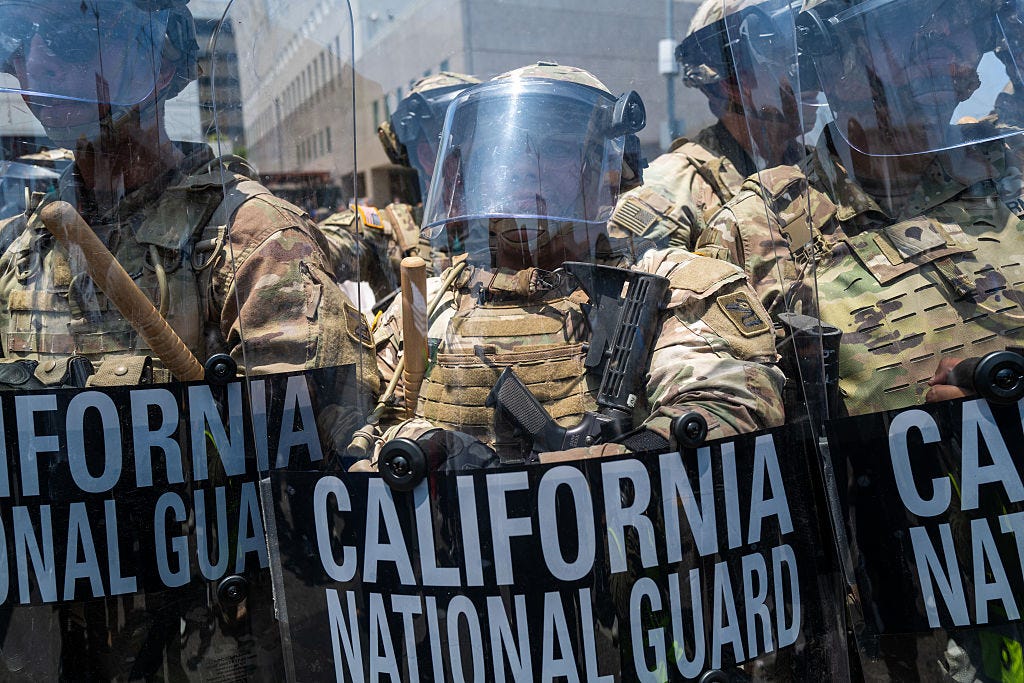Join us live today, Monday, June 9, at 12:30 p.m. Eastern for a conversation with Ruth Ben-Ghiat. You can watch our Live events on your desktop at The Ink or on your phone or tablet with the Substack app. We’ve got more great conversations coming up this week — see below for details on those, and an important note on Book Club’s move to Zoom.
“Troops Called After New Riot; Marshals and Police Fight Mob: Tear Gas Is Used,” “Federalized Guardsmen Grim Faced in Uniform,” “Reason — Not Intimidation.”
Headlines from today’s papers? No, headlines from coverage of the civil rights movement, from more than six decades ago.
As the country takes stock of what happened over the past week as communities came together to challenge ICE actions, and people and pundits debate whether neighborhoods standing up to armed law enforcement and military backup amounts to poking the bear, it’s worth looking back to the 1960s. To 1963, specifically, when a majority of Americans felt that mass demonstrations were hurting the civil rights movement. This is after Dr. Martin Luther King, Jr.’s “I Have a Dream” speech.
This coming weekend, on June 14, Washington D.C. will host the largest military parade in decades; a celebration of 250 years of the U.S. Army to mark Flag Day — and Donald Trump’s birthday. This happens as the Republican Congress looks to further tighten its direct control over the D.C. government.
And on the same day, a nationwide day of action — “No Kings” — will see Americans in the streets in peaceful protest in thousands of cities and towns (though not in D.C.; organizers are not looking for contrast, not confrontation).
To make sense of it all, join us today at 12:30 p.m. Eastern as we talk with Ruth Ben-Ghiat. In the meantime, some questions to consider:
Who’s behind the violence on the streets of Los Angeles?
What do we consider “violence” — and who gets to define it?
What are the acceptable limits of protest?
How can people respond to attacks on their neighbors and communities?
Do these latest escalations put the country on a darker path?
Is the New York City mayoral race a real contest at last?
What will the June 14 military parade cost the country?
Where exactly are the limits on free speech?
What is the Supreme Court likely to decide before it goes on summer recess?
Are tech firms building a plain old surveillance state on top of the surveillance capitalism we’ve become used to?
As the U.S. government abandons efforts to solve real problems, is it turning its resources to tackling imaginary threats?
And visit the links below for some of our previous coverage of protest, its meaning, and its impact:
Your support is how we keep the lights on, pay our writers and editors a fair wage, and build the new media we all deserve. When you subscribe, you help us reach more people. Join us today, or if you already have, give a gift or group subscription.
More Live conversations this week!
Join us today, Monday, June 9, at 12:30 p.m. Eastern, for our conversation with scholar of authoritarianism Ruth Ben-Ghiat. Tomorrow, Tuesday, June 10, at 12:30 p.m. Eastern, we’ll speak to journalists Jake Tapper and Alex Thompson about Joe Biden and the future of the Democratic Party. On Wednesday, June 11, at 12:30 p.m. Eastern, we’ll meet with The Ink Book Club (This week’s conversation is moving to Zoom; Details at the bottom of this post). And on Thursday, June 12, at 12:30 p.m. Eastern, we’re back with political sage Anat Shenker-Osorio.
To join and watch, download the Substack app (click on the button below) and turn on notifications — you’ll get an alert once we’re live, and you can watch, chat, and even participate in the conversation during our Book Club meetings from your iOS or Android mobile device. If you’re using a computer, you can also watch (and ask questions in the text chat) on our homepage.
This post was originally published on The.Ink.

